radiator cap KIA Optima 2016 4.G Owner's Manual
[x] Cancel search | Manufacturer: KIA, Model Year: 2016, Model line: Optima, Model: KIA Optima 2016 4.GPages: 623, PDF Size: 15.4 MB
Page 15 of 623
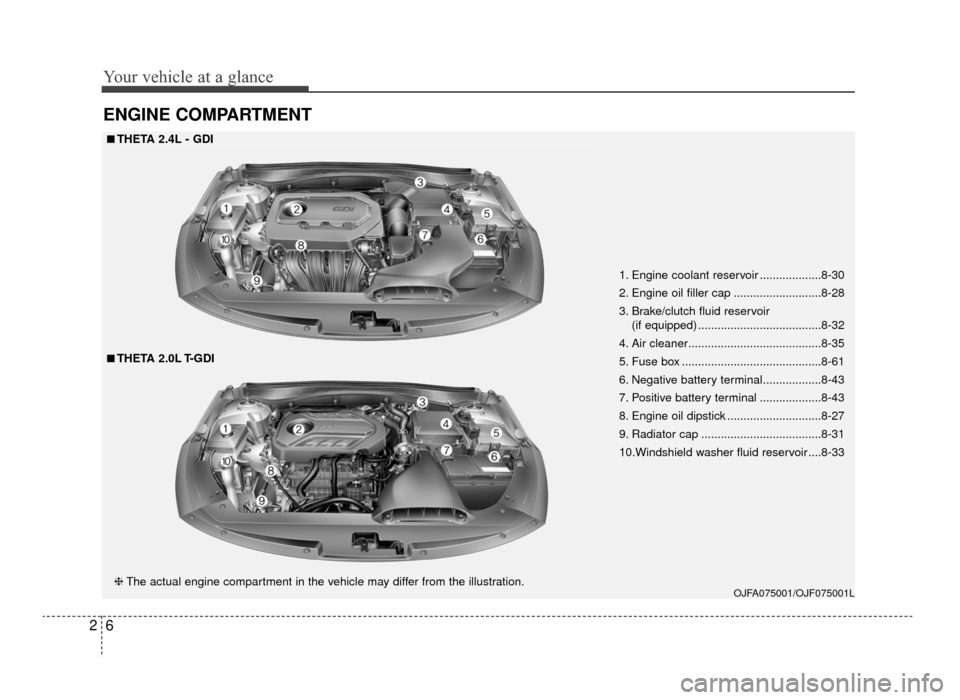
Your vehicle at a glance
62
ENGINE COMPARTMENT
OJFA075001/OJF075001L
■
■THETA 2.4L - GDI
❈ The actual engine compartment in the vehicle may differ from the illustration.
■
■THETA 2.0L T-GDI 1. Engine coolant reservoir ...................8-30
2. Engine oil filler cap ...........................8-28
3. Brake/clutch fluid reservoir
(if equipped) ......................................8-32
4. Air cleaner.........................................8-35
5. Fuse box ...........................................8-61
6. Negative battery terminal..................8-43
7. Positive battery terminal ...................8-43
8. Engine oil dipstick .............................8-27
9. Radiator cap .....................................8-31
10.Windshield washer fluid reservoir ....8-33
JF CAN (ENG) 2.qxp 9/22/2015 6:51 PM Page 6
Page 16 of 623
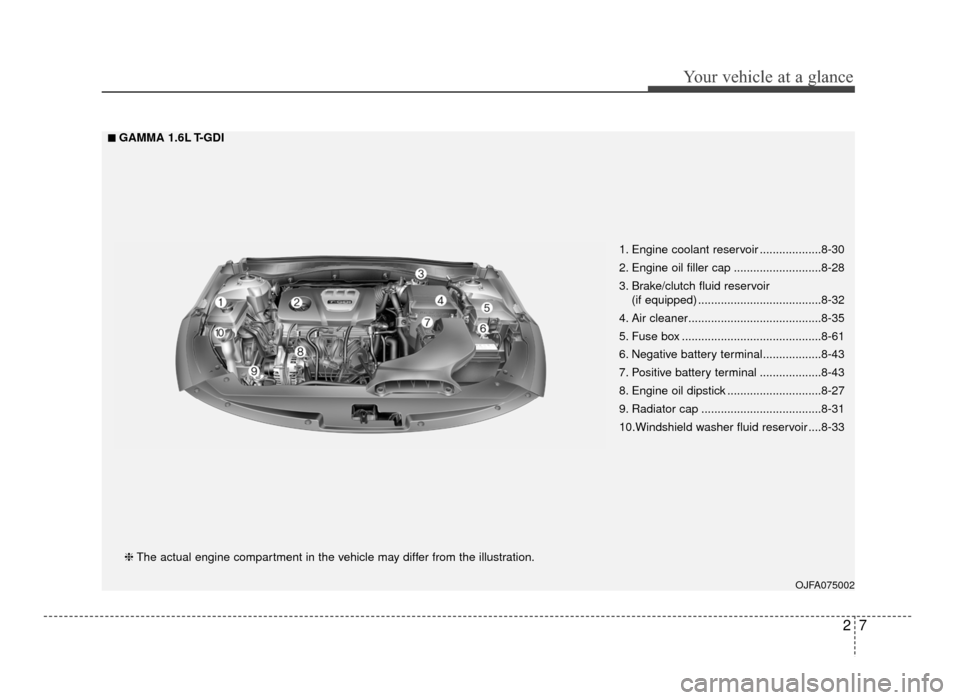
27
Your vehicle at a glance
OJFA075002
■
■GAMMA 1.6L T-GDI❈ The actual engine compartment in the vehicle may differ from the illustration. 1. Engine coolant reservoir ...................8-30
2. Engine oil filler cap ...........................8-28
3. Brake/clutch fluid reservoir
(if equipped) ......................................8-32
4. Air cleaner.........................................8-35
5. Fuse box ...........................................8-61
6. Negative battery terminal..................8-43
7. Positive battery terminal ...................8-43
8. Engine oil dipstick .............................8-27
9. Radiator cap .....................................8-31
10.Windshield washer fluid reservoir ....8-33
JF CAN (ENG) 2.qxp 9/22/2015 6:51 PM Page 7
Page 123 of 623
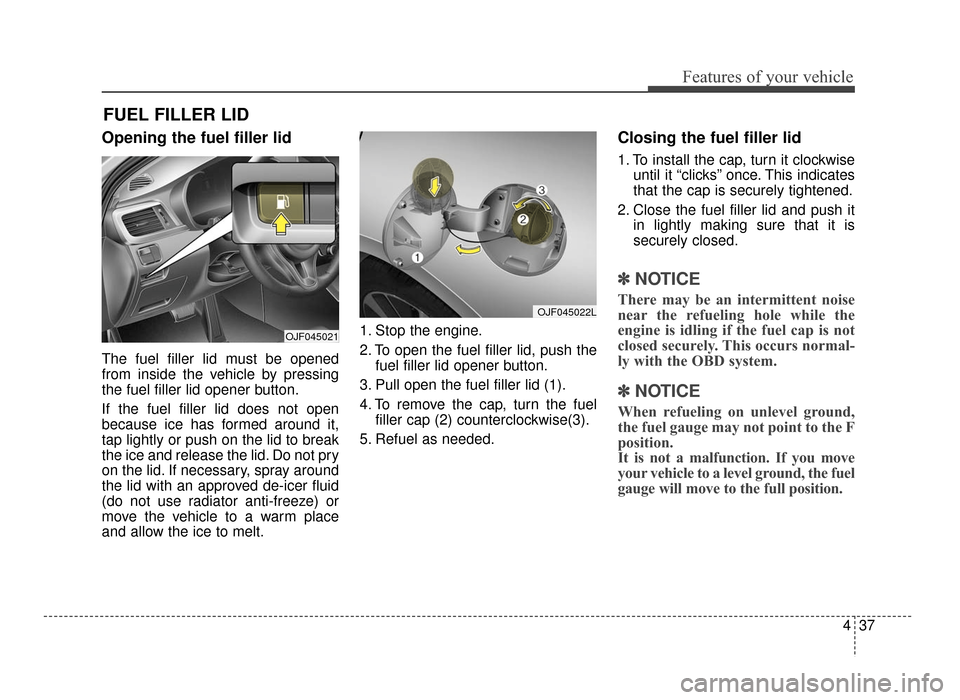
437
Features of your vehicle
Opening the fuel filler lid
The fuel filler lid must be opened
from inside the vehicle by pressing
the fuel filler lid opener button.
If the fuel filler lid does not open
because ice has formed around it,
tap lightly or push on the lid to break
the ice and release the lid. Do not pry
on the lid. If necessary, spray around
the lid with an approved de-icer fluid
(do not use radiator anti-freeze) or
move the vehicle to a warm place
and allow the ice to melt.1. Stop the engine.
2. To open the fuel filler lid, push the
fuel filler lid opener button.
3. Pull open the fuel filler lid (1).
4. To remove the cap, turn the fuel filler cap (2) counterclockwise(3).
5. Refuel as needed.
Closing the fuel filler lid
1. To install the cap, turn it clockwise until it “clicks” once. This indicates
that the cap is securely tightened.
2. Close the fuel filler lid and push it in lightly making sure that it is
securely closed.
✽ ✽NOTICE
There may be an intermittent noise
near the refueling hole while the
engine is idling if the fuel cap is not
closed securely. This occurs normal-
ly with the OBD system.
✽ ✽NOTICE
When refueling on unlevel ground,
the fuel gauge may not point to the F
position.
It is not a malfunction. If you move
your vehicle to a level ground, the fuel
gauge will move to the full position.
FUEL FILLER LID
OJF045021
OJF045022L
JF CAN (ENG) 4.qxp 11/5/2015 3:50 PM Page 37
Page 145 of 623
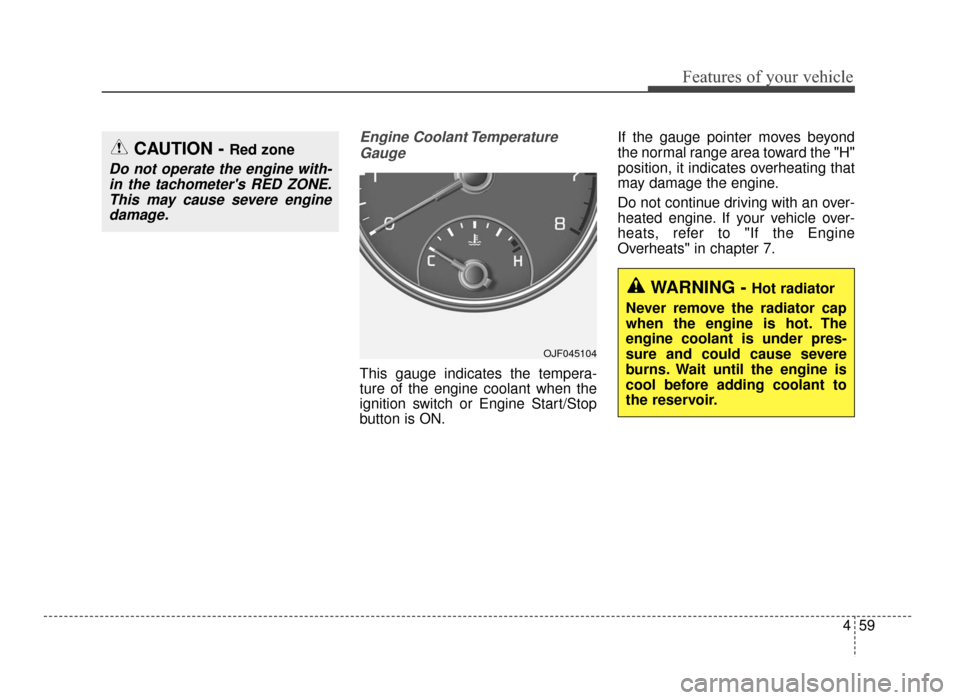
459
Features of your vehicle
Engine Coolant TemperatureGauge
This gauge indicates the tempera-
ture of the engine coolant when the
ignition switch or Engine Start/Stop
button is ON. If the gauge pointer moves beyond
the normal range area toward the "H"
position, it indicates overheating that
may damage the engine.
Do not continue driving with an over-
heated engine. If your vehicle over-
heats, refer to "If the Engine
Overheats" in chapter 7.
CAUTION - Red zone
Do not operate the engine with-
in the tachometer's RED ZONE.This may cause severe enginedamage.
OJF045104
WARNING - Hot radiator
Never remove the radiator cap
when the engine is hot. The
engine coolant is under pres-
sure and could cause severe
burns. Wait until the engine is
cool before adding coolant to
the reservoir.
JF CAN (ENG) 4.qxp 11/5/2015 3:50 PM Page 59
Page 474 of 623
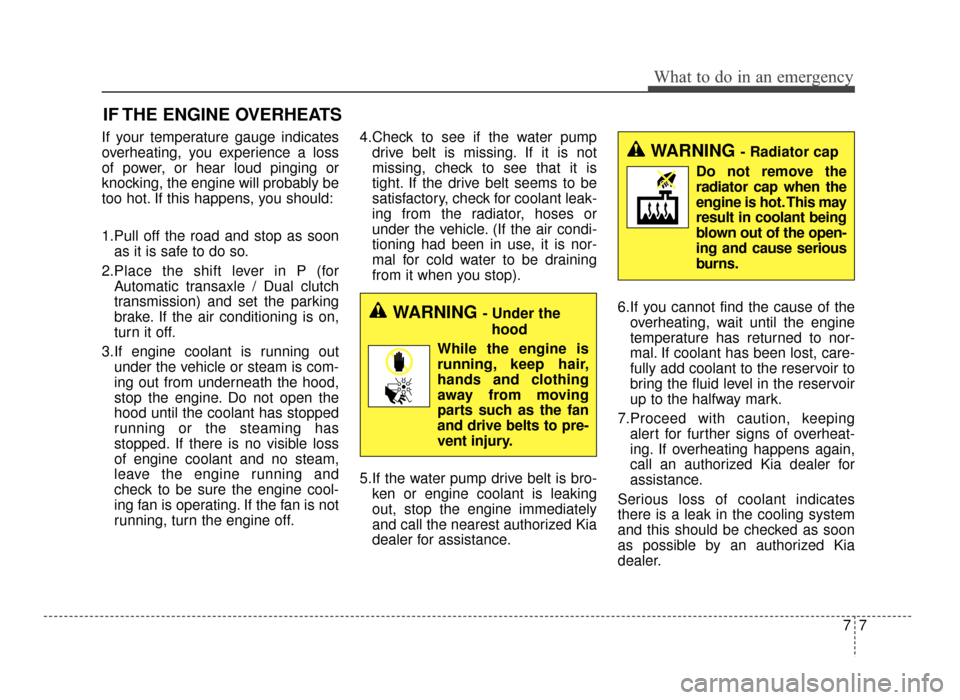
77
What to do in an emergency
IF THE ENGINE OVERHEATS
If your temperature gauge indicates
overheating, you experience a loss
of power, or hear loud pinging or
knocking, the engine will probably be
too hot. If this happens, you should:
1.Pull off the road and stop as soonas it is safe to do so.
2.Place the shift lever in P (for Automatic transaxle / Dual clutch
transmission) and set the parking
brake. If the air conditioning is on,
turn it off.
3.If engine coolant is running out under the vehicle or steam is com-
ing out from underneath the hood,
stop the engine. Do not open the
hood until the coolant has stopped
running or the steaming has
stopped. If there is no visible loss
of engine coolant and no steam,
leave the engine running and
check to be sure the engine cool-
ing fan is operating. If the fan is not
running, turn the engine off. 4.Check to see if the water pump
drive belt is missing. If it is not
missing, check to see that it is
tight. If the drive belt seems to be
satisfactory, check for coolant leak-
ing from the radiator, hoses or
under the vehicle. (If the air condi-
tioning had been in use, it is nor-
mal for cold water to be draining
from it when you stop).
5.If the water pump drive belt is bro- ken or engine coolant is leaking
out, stop the engine immediately
and call the nearest authorized Kia
dealer for assistance. 6.If you cannot find the cause of the
overheating, wait until the engine
temperature has returned to nor-
mal. If coolant has been lost, care-
fully add coolant to the reservoir to
bring the fluid level in the reservoir
up to the halfway mark.
7.Proceed with caution, keeping alert for further signs of overheat-
ing. If overheating happens again,
call an authorized Kia dealer for
assistance.
Serious loss of coolant indicates
there is a leak in the cooling system
and this should be checked as soon
as possible by an authorized Kia
dealer.
WARNING - Under the hood
While the engine is running, keep hair,
hands and clothing
away from moving
parts such as the fan
and drive belts to pre-
vent injury.
WARNING - Radiator cap
Do not remove the
radiator cap when the
engine is hot. This may
result in coolant being
blown out of the open-
ing and cause serious
burns.
JF CAN (ENG) 7.qxp 11/5/2015 4:24 PM Page 7
Page 502 of 623
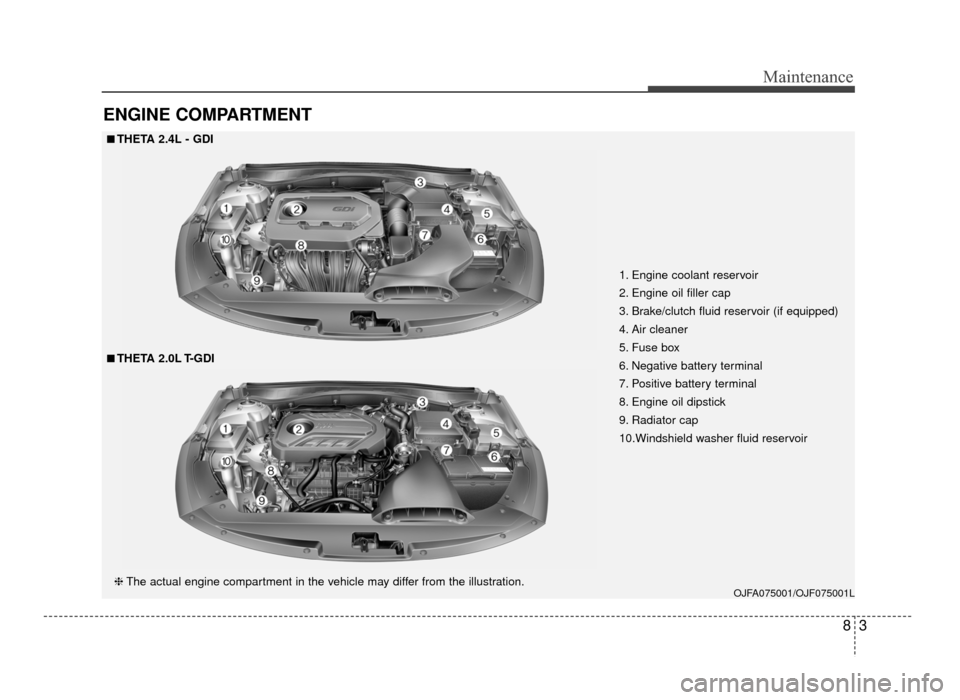
83
Maintenance
ENGINE COMPARTMENT
OJFA075001/OJF075001L
■
■THETA 2.4L - GDI
❈ The actual engine compartment in the vehicle may differ from the illustration.
■
■THETA 2.0L T-GDI 1. Engine coolant reservoir
2. Engine oil filler cap
3. Brake/clutch fluid reservoir (if equipped)
4. Air cleaner
5. Fuse box
6. Negative battery terminal
7. Positive battery terminal
8. Engine oil dipstick
9. Radiator cap
10.Windshield washer fluid reservoir
JF CAN (ENG) 8.qxp 11/5/2015 6:40 PM Page 3
Page 503 of 623
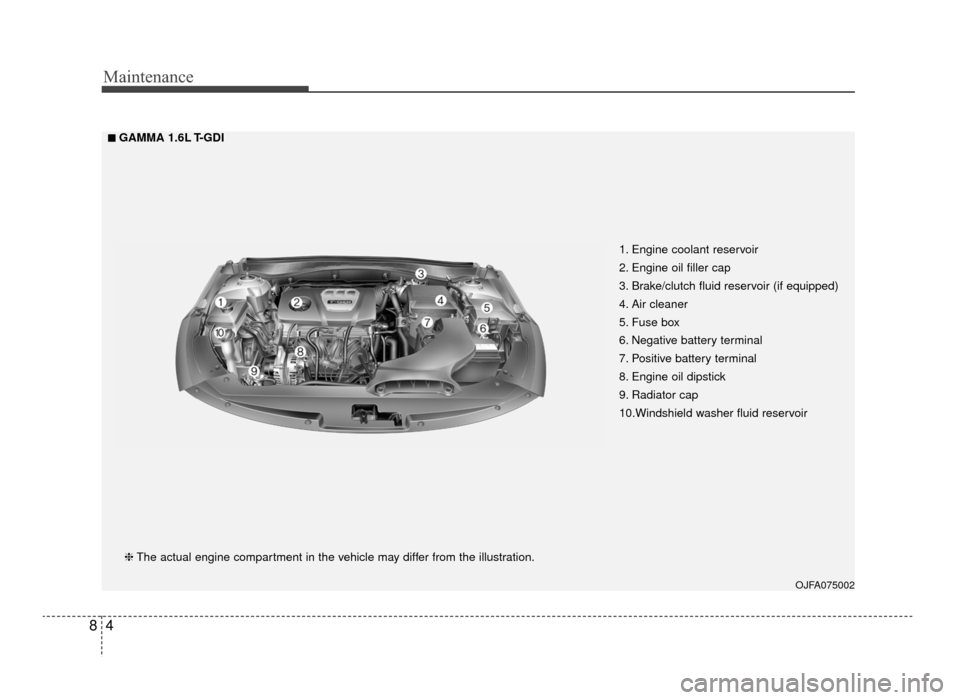
Maintenance
48
OJFA075002
■
■GAMMA 1.6L T-GDI❈ The actual engine compartment in the vehicle may differ from the illustration. 1. Engine coolant reservoir
2. Engine oil filler cap
3. Brake/clutch fluid reservoir (if equipped)
4. Air cleaner
5. Fuse box
6. Negative battery terminal
7. Positive battery terminal
8. Engine oil dipstick
9. Radiator cap
10.Windshield washer fluid reservoir
JF CAN (ENG) 8.qxp 11/5/2015 6:40 PM Page 4
Page 528 of 623
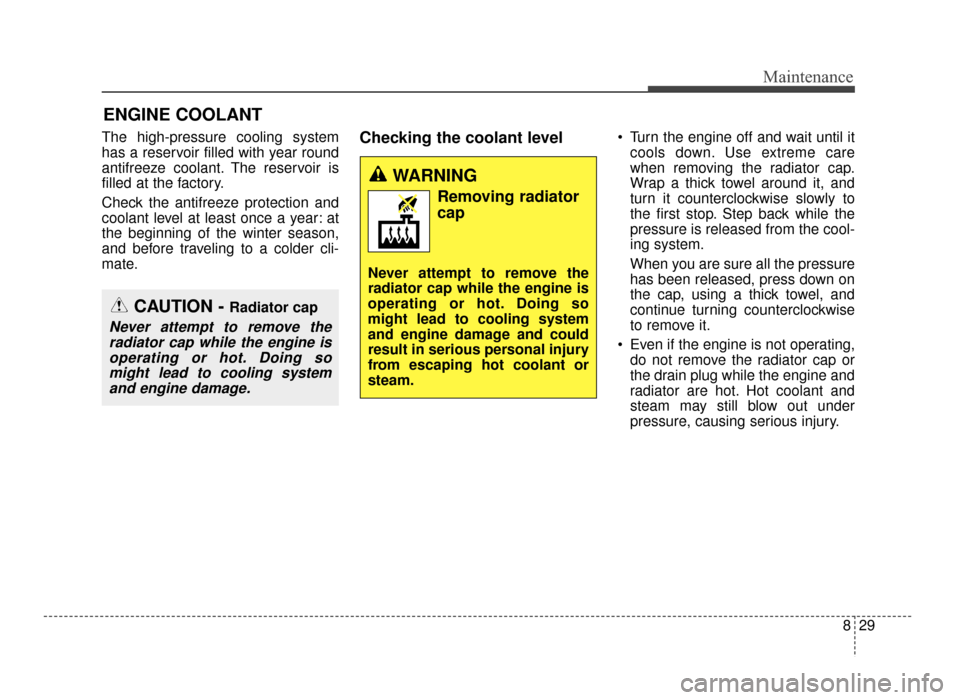
829
Maintenance
ENGINE COOLANT
The high-pressure cooling system
has a reservoir filled with year round
antifreeze coolant. The reservoir is
filled at the factory.
Check the antifreeze protection and
coolant level at least once a year: at
the beginning of the winter season,
and before traveling to a colder cli-
mate.Checking the coolant level Turn the engine off and wait until itcools down. Use extreme care
when removing the radiator cap.
Wrap a thick towel around it, and
turn it counterclockwise slowly to
the first stop. Step back while the
pressure is released from the cool-
ing system.
When you are sure all the pressure
has been released, press down on
the cap, using a thick towel, and
continue turning counterclockwise
to remove it.
Even if the engine is not operating, do not remove the radiator cap or
the drain plug while the engine and
radiator are hot. Hot coolant and
steam may still blow out under
pressure, causing serious injury.
WARNING
Removing radiator
cap
Never attempt to remove the
radiator cap while the engine is
operating or hot. Doing so
might lead to cooling system
and engine damage and could
result in serious personal injury
from escaping hot coolant or
steam.
CAUTION - Radiator cap
Never attempt to remove theradiator cap while the engine isoperating or hot. Doing somight lead to cooling systemand engine damage.
JF CAN (ENG) 8.qxp 11/5/2015 6:40 PM Page 29
Page 530 of 623
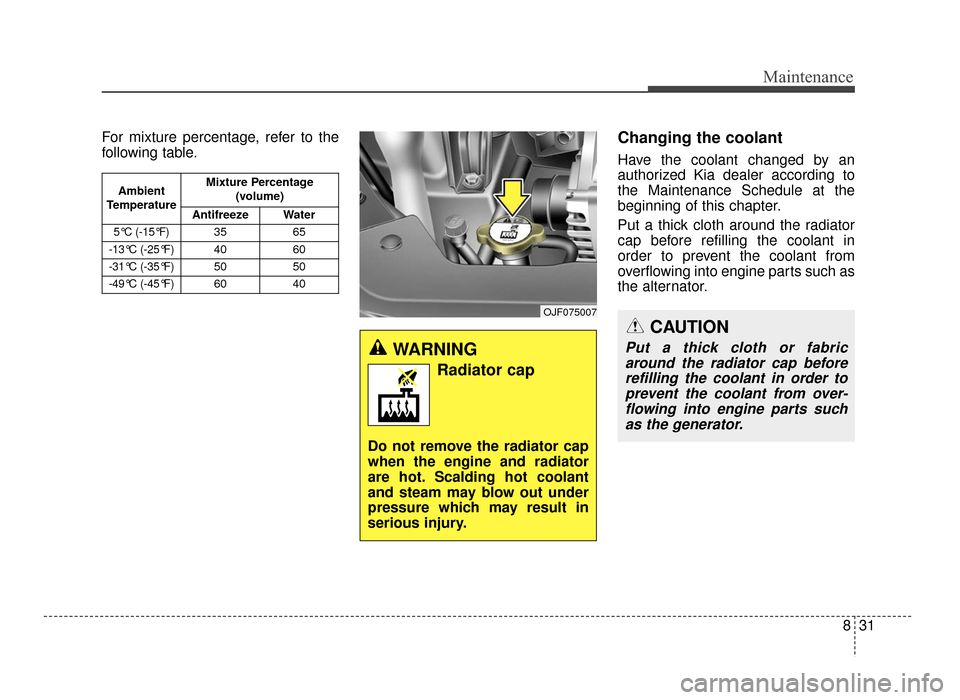
831
Maintenance
For mixture percentage, refer to the
following table.Changing the coolant
Have the coolant changed by an
authorized Kia dealer according to
the Maintenance Schedule at the
beginning of this chapter.
Put a thick cloth around the radiator
cap before refilling the coolant in
order to prevent the coolant from
overflowing into engine parts such as
the alternator.
OJF075007
Ambient
Temperature Mixture Percentage
(volume)
Antifreeze Water
5°C (-15°F)35 65
-13°C (-25°F)4060
-31°C (-35°F)5050
-49°C (-45°F)6040
WARNING
Radiator cap
Do not remove the radiator cap
when the engine and radiator
are hot. Scalding hot coolant
and steam may blow out under
pressure which may result in
serious injury.
CAUTION
Put a thick cloth or fabric
around the radiator cap beforerefilling the coolant in order toprevent the coolant from over-flowing into engine parts suchas the generator.
JF CAN (ENG) 8.qxp 11/5/2015 6:40 PM Page 31